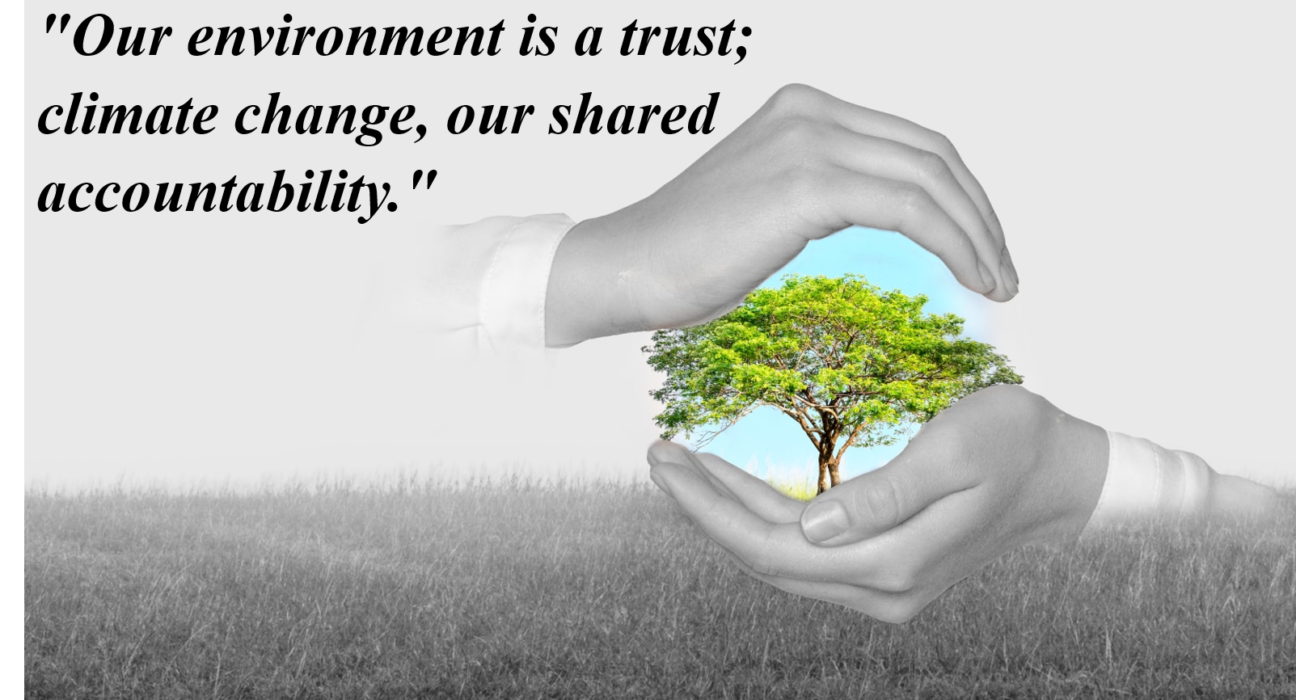Author : Mr. Arunachaleshwar V
Editor : Dr. Vignesh K
“Our environment is a trust; climate change, our shared accountability.”
Introduction: The Role of Fossil Fuels in Climate Change
For over a century, fossil fuels have been integral to economic growth and industrialization, but their environmental impact has created global concerns. The combustion of fossil fuels for energy contributes approximately 69% of greenhouse gas emissions worldwide, leading to global warming and environmental degradation (Asselt & Kulovesi, 2017). This increase in greenhouse gases has caused average global temperatures to rise by approximately 1.17°C above pre-industrial levels, with the potential for further warming if significant actions are not taken. Limiting this increase to below 1.5°C is critical to mitigate the worst impacts of climate change. If temperatures rise beyond this threshold, particularly above 3°C, the risk of widespread ecological disruption becomes imminent, putting both biodiversity and human systems at risk (Asselt & Green, 2022).
The devastating environmental effects of fossil fuels have been widely known within scientific communities and industry since the 1960s. However, fossil fuel corporations have historically downplayed their role in climate change, often through targeted disinformation campaigns that have delayed significant climate policy efforts and hindered societal responses to climate threats (Dahl et al., 2023). In addition to reducing carbon emissions, managing the supply and consumption of fossil fuels is essential to achieve the targets outlined in the Paris Agreement, which aims to keep global warming well below 2°C (Piggot, 2017).
The Principle of Common but Differentiated Responsibilities (CBDR)
Acknowledging the historical emissions of developed nations, the “Common but Differentiated Responsibilities” (CBDR) principle was formalized in 1992 to promote equitable climate policies. According to this principle, while all nations share the responsibility to address climate change, their obligations vary based on their contributions to historical emissions and their current capabilities. Developed countries, as major historical emitters, are thus expected to lead global mitigation efforts, while developing nations require financial and technical support to transition to sustainable economies (Setzer & Vanhala, 2019). CBDR is pivotal in structuring climate finance mechanisms and fostering trust among countries, as it acknowledges both the varying contributions to the problem and the differing abilities to implement solutions (Skovgaard & Asselt, 2019).
Climate Finance and the Path Toward Renewable Energy
Transitioning from fossil fuels to renewable energy demands substantial financial resources, especially for developing nations that may lack the financial means to implement large-scale renewable projects. Recognizing this, the 2009 COP15 Copenhagen Summit set an ambitious goal: developed nations would mobilize $100 billion annually to support climate actions in developing countries, focusing on both mitigation and adaptation (UNFCCC, 2009). Though this target was achieved in 2022, contributions fell slightly short in 2021, totaling around $90 billion (Dahl et al., 2023). This funding was allocated with 60% for mitigation, 27% for adaptation, and 13% for cross-cutting purposes. The distribution has sparked debate, with many advocating for a balanced 50-50 split between mitigation and adaptation funding to address the immediate adaptation needs of countries facing severe climate-related impacts (Asselt & Green, 2022).
Moving forward, further negotiations aim to solidify more ambitious financial goals, including provisions for “loss and damage” compensation to support countries disproportionately affected by climate change. This concept underscores the reality that some climate impacts are already unavoidable, requiring financial resources to address the damage that vulnerable countries face (Setzer & Vanhala, 2019).
Key Financial Strategies to Support Climate Finance
- Increasing Public and Private Investments: Both sectors are encouraged to invest more substantially in environmental initiatives (Climate Policy Initiative, 2022).
- Eliminating Environmentally Harmful Subsidies: Redirecting subsidies away from fossil fuels and other harmful industries to promote sustainable alternatives (Gazmararian, 2022).
- Expanding Financial Inclusion: Ensuring equitable access to financial resources for marginalized communities to foster sustainable development (Plantinga & Scholtens, 2020).
- Integrating Climate Risks into Financial Systems: Factoring climate risks into economic planning to make financial systems resilient (Burnham, 2021).
- Implementing Emission Pricing: Establishing a monetary value on greenhouse gas emissions to disincentivize pollution and promote greener practices (Luo et al., 2022).
Emission Pricing: A Market-Driven Solution to Greenhouse Gas Reduction
Emission pricing, including carbon taxes and cap-and-trade systems, is a widely endorsed approach to internalize the cost of pollution, driving both individuals and corporations to reduce emissions. By attributing a price to carbon emissions, governments can incentivize reductions in fossil fuel consumption and stimulate innovation in renewable technologies (Covert et al., 2016). Emission pricing has been implemented globally in various forms, each with distinct advantages and challenges.
Methods of Emission Pricing
- Carbon Tax: A straightforward approach where a fixed price is applied per ton of CO₂ emitted. This tax structure is designed to discourage fossil fuel use and drive businesses toward sustainable energy.
- Cap-and-Trade Systems: A regulatory framework where a cap is set on emissions, and businesses are allowed to trade emissions permits. The European Union’s Emissions Trading System is a notable example, progressively reducing allowable emissions over time.
- Fees for Broader Environmental Impacts: Extending beyond CO₂, fees on pollutants like plastic and water incentivize sustainable practices and decrease environmental degradation.
Advantages of Emission Pricing
- Incentivizes Emission Reductions: Higher costs for pollution encourage businesses and individuals to adopt sustainable practices (Burnham, 2021).
- Fosters Innovation: Carbon pricing stimulates research and development in clean technology and renewable energy (Luo et al., 2022).
- Revenue for Climate Projects: The funds generated from emission pricing can support renewable energy and climate resilience projects (Climate Policy Initiative, 2022).
- Encourages Behavioral Shifts: Higher prices for high-emission goods can make eco-friendly alternatives more attractive to consumers.
Challenges of Emission Pricing
- Determining Optimal Pricing: Setting a carbon price that balances effectiveness with economic feasibility is complex. If too low, it fails to drive significant change; if too high, it may burden industries and consumers (Engström & Gars, 2016).
- Equity Considerations: Carbon pricing can disproportionately affect low-income populations, necessitating targeted subsidies or rebates (Gazmararian, 2022).
- Global Coordination: Climate change requires a globally harmonized approach. Without international collaboration, companies might relocate to regions with less stringent regulations, undermining global emission reduction efforts (Setzer & Vanhala, 2019).
Divestment and Fossil Fuel Subsidy Reform
The divestment movement advocates for withdrawing investments from fossil fuel companies as a strategic financial measure to shift resources toward sustainable alternatives. Though divestment alone may not directly reduce emissions, it plays a significant role in altering public discourse and investor behavior (Ayling, 2017). Redirecting funds away from fossil fuels sends a powerful message that these industries are incompatible with a sustainable future. Additionally, reforming fossil fuel subsidies, which often encourage fossil fuel production and consumption, is a crucial step in climate policy. While such reforms present political challenges, they could potentially redirect billions of dollars toward renewable energy development and sustainable practices (Skovgaard & Asselt, 2019).
Loss and Damage Compensation for Climate-Vulnerable Nations
In recognition of the disproportionate impact of climate change on certain nations, loss and damage compensation has become a focal point in international climate negotiations. This concept advocates financial support for countries experiencing severe, often unavoidable climate-related losses. As part of the ongoing discussions, mechanisms are being developed to address the irreversible impacts of climate change on vulnerable communities and ecosystems (Chad S. Boda, 2021). Compensation funds would help these countries rebuild, adapt, and bolster their resilience against future climate threats. Establishing a structured approach for loss and damage compensation is essential for creating a fair and supportive international climate framework (Loss and Damage Collaboration, 2021).
The Importance of Innovation in Tackling Climate Change
Innovation in technology, energy systems, and sustainable practices is essential for achieving long-term climate goals. Investments in renewable energy technologies like wind, solar, and battery storage are transforming the energy landscape and reducing dependency on fossil fuels. Additionally, advances in carbon capture and storage (CCS), energy efficiency, and smart grid technology contribute to reducing emissions while maintaining reliable energy access (Climate Policy Initiative, 2022). Transitioning to sustainable practices not only mitigates climate change but also generates economic opportunities, creating green jobs and promoting cleaner industries. For instance, research indicates that green technologies can significantly boost GDP by enhancing energy efficiency and reducing energy costs.
Conclusion: A Path Forward
Tackling climate change is a complex, multi-faceted challenge that requires the combined efforts of governments, businesses, and individuals worldwide. Climate finance, emission pricing, and innovations in renewable energy are crucial pillars in this effort. The principle of CBDR remains a vital foundation for climate policy, emphasizing that while all nations must contribute to climate solutions, developed countries should lead and support developing nations in their transitions. Emission pricing offers a promising pathway to internalize the cost of pollution and promote sustainable practices, although careful attention must be given to its social and economic impacts.
As climate-related losses continue to mount, establishing reliable mechanisms for loss and damage compensation will be essential to support vulnerable countries. Innovation, especially in renewable energy, will drive future progress, offering sustainable alternatives to fossil fuels. The transition to a low-carbon world demands robust policies, equitable financial mechanisms, and technological advancements that prioritize the well-being of people and ecosystems alike.
Final Reflection
Addressing climate change requires a paradigm shift in how we value our environment, with each action reflecting a commitment to sustainability and justice. The global challenge of climate change transcends borders, ideologies, and economic interests, calling for a united response grounded in equity, responsibility, and resilience. As we move forward, the path to sustainability will be guided not only by policies and technologies but by a shared recognition that our environment is a collective inheritance, a legacy we shape together.
“In the battle against climate change, every choice is a testament to our commitment to future generations.”
Reference
- Adaptation Fund. (2020). “Adaptation Fund Annual Performance Report 2020.” Retrieved from Adaptation Fund(https://www.adaptation-fund.org/wp-content/uploads/2021/03/Adaptation-Fund-Annual-Performance-Report-2020.pdf).
- Asselt, H. and Green, F. (2022). cop26 and the dynamics of anti‐fossil fuel norms. Wiley Interdisciplinary Reviews Climate Change, 14(3). https://doi.org/10.1002/wcc.816
- Asselt, H. and Kulovesi, K. (2017). Seizing the opportunity: tackling fossil fuel subsidies under the unfccc. International Environmental Agreements Politics Law and Economics, 17(3), 357-370. https://doi.org/10.1007/s10784-017-9357-x
- Ayling, J. (2017). A contest for legitimacy: the divestment movement and the fossil fuel industry. Law & Policy, 39(4), 349-371. https://doi.org/10.1111/lapo.12087
- Burnham, J. (2021). Climate change and antibiotic resistance: a deadly combination. Therapeutic Advances in Infectious Disease, 8. https://doi.org/10.1177/2049936121991374
- Climate Policy Initiative. (2022). “Global Climate Finance: Trends and Opportunities.” Retrieved from CPI(https://www.climatepolicyinitiative.org/publication/global-climate-finance-trends-and-opportunities/).
- Covert, T., Greenstone, M., & Knittel, C. (2016). Will we ever stop using fossil fuels?. Journal of Economic Perspectives, 30(1), 117-138. https://doi.org/10.1257/jep.30.1.117
- Dahl, K., Phillips, C., Race, A., Udvardy, S., & Ortiz‐Partida, J. (2023). The fossil fuels behind forest fires.. https://doi.org/10.47923/2023.15046
- Engström, G. and Gars, J. (2016). Climatic tipping points and optimal fossil-fuel use. Environmental and Resource Economics, 65(3), 541-571. https://doi.org/10.1007/s10640-016-0042-2
- Gazmararian, A. (2022). Energy communities support climate policy in exchange for transition assistance.. https://doi.org/10.21203/rs.3.rs-1865306/v4
- Green Climate Fund. (2021). “GCF Annual Report 2021.” Retrieved from GCF(https://www.greenclimate.fund/document/annual-report-2021).
- Loss and Damage Collaboration. (2021). “Understanding Loss and Damage.” Retrieved from Loss and Damage(https://www.lossanddamagecollaboration.org/).
- Luo, Y., Ahmadi, E., McLellan, B., & Tezuka, T. (2022). Will capacity mechanisms conflict with carbon pricing?. Energies, 15(24), 9559. https://doi.org/10.3390/en15249559
- Piggot, G. (2017). The influence of social movements on policies that constrain fossil fuel supply. Climate Policy, 18(7), 942-954. https://doi.org/10.1080/14693062.2017.1394255
- Plantinga, A. and Scholtens, B. (2020). The financial impact of fossil fuel divestment. Climate Policy, 21(1), 107-119. https://doi.org/10.1080/14693062.2020.1806020
- Roberts, J. T., & Pelling, M. (2018). “Climate Change and the Politics of Loss and Damage.” *Global Environmental Change*, 48, 1-10. doi:10.1016/j.gloenvcha.2017.09.003.
- Setzer, J. and Vanhala, L. (2019). Climate change litigation: a review of research on courts and litigants in climate governance. Wiley Interdisciplinary Reviews Climate Change, 10(3). https://doi.org/10.1002/wcc.580
- Skovgaard, J. and Asselt, H. (2019). The politics of fossil fuel subsidies and their reform: implications for climate change mitigation. Wiley Interdisciplinary Reviews Climate Change, 10(4). https://doi.org/10.1002/wcc.581
- United Nations Framework Convention on Climate Change (UNFCCC). (2009). “Copenhagen Accord.” Retrieved from UNFCCC(https://unfccc.int/resource/docs/2009/cop15/eng/l07.pdf).



